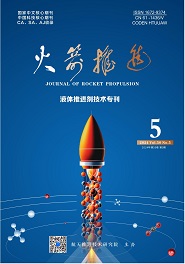航天推进技术研究院主办
LIU Xue,YANG Haiwei,ZHOU Weixing.Numerical simulation research on transpiration cooling on the inner wall of combustion chamber[J].Journal of Rocket Propulsion,2021,47(04):30-37.
燃烧室内壁面发汗冷却数值模拟研究
- Title:
- Numerical simulation research on transpiration cooling on the inner wall of combustion chamber
- 文章编号:
- 1672-9374(2021)04-0030-07
- 分类号:
- V430
- 文献标志码:
- A
- 摘要:
- 燃烧室内的高热流会使得燃烧室内壁面因烧蚀而破坏,发汗冷却作为一种先进的冷却技术可用作燃烧室内壁面的热防护过程中。通过平板发汗冷却模型研究了发动机燃烧室内壁面在不同热流密度下温度分布,结果显示随着热流密度的增大,壁面温度线性上升。通过研究多孔介质几何结构对发汗冷却效果的影响,发现在保持其他变量不变的条件下,孔隙率与孔径的增大均会导致固体壁面温度的上升,不利于固体壁面的保护。模拟结果表明,冷却工质流量的增大使得热端壁面温度快速下降,即使增加微小的流量也会起到明显的降温效果,热壁面温度与冷却剂流量符合幂函数关系,相关度较高。
- Abstract:
- The high heat flux in the combustion chamber will damage the walls in the combustion chamber due to ablation.As an advanced cooling technology,transpiration cooling can be used in the process of thermal protection of the walls in the combustion chamber.In this paper,the plate transpiration cooling model was used to study the temperature distribution of the wall in the engine combustion chamber at different heat flux conditions.The results show that the wall temperature increases linearly with the increase of heat flux.By studying the influence of the geometric structure of porous media on the transpiration cooling effect,it was found that the increase of porosity and pore size will lead to the rise of solid wall temperature when other variables remain unchanged,which is not favorable to the protection of solid wall.The simulation results show that the increase of the coolant flow rate makes the temperature of the hot end wall drop rapidly,and even a small increase of the flow rate will have an obvious cooling effect.The temperature of the hot wall and the coolant flow are in a power function relationship,and the correlation is high.
参考文献/References:
[1] 蔡亚梅,汪立萍.美国的高超声速飞行器发展计划及关键技术分析[J].航天制造技术,2010(6):4-7.
[2] RANGESH J,SCHUYLER H W,CRAIG J.Performance assessment of supersonic and hypersonic intake systems with nano-particle injection[J].Acta Astronautica,2019,159:609-621.
[3] 张忠利,张蒙正,周立新.液体火箭发动机热防护[M].北京:国防工业出版社,2016.
[4] 丁锐.发散冷却在高超声速飞行器上的应用可行性研究[D].合肥:中国科学技术大学,2020.
[5] HASSAN A R,SALAWU S O.Analysis of buoyancy driven flow of a reactive heat generating third grade fluid in a parallel channel having convective boundary conditions[J].SN Applied Sciences,2019,1(8):1-9.
[6] KAYANSAYAN N,KUCUKA S.Impingement cooling of a semi-cylindrical concave channel by confined slotairjet[J].Experimental Thermal and Fluid Science,2001,25(6):383-396.
[7] LIU D D,TAO Z,LUO X.Experimental investigation of heat transfer characteristics on turbine endwall with full coverage film cooling[J].Applied Thermal Engineering,2018,140:295-303.
[8] JIANG P X,LIAO Z Y,HUANG Z,et al.Influence of shock waves on supersonic transpiration cooling[J].International Journal of Heat and Mass Transfer,2019,(129):965-974.
[9] XIAO X F,ZHAO G B,ZHOU W X,et al.Large-eddy simulation of transpiration cooling in turbulent channel with porous wall[J].Applied Thermal Engineering,2018,145:618-629.
[10] DING R,WANG J H,HE F,et al.Numerical investigation on the performances of porous matrix with transpiration and film cooling[J].Applied Thermal Engineering,2019,146:422-431.
[11] HE F,DONG W J,WANG J H,et al.Transient model and its application to investigate the injection mode and periodical operation of transpiration cooling with liquid coolant phase change[J].Applied Thermal Engineering,2020,181:115956.
[12] KUMAR S,SINGH O.Performance evaluation of a transpiration-cooled gas turbine for different coolants and permissible blade temperatures considering the effect of radiation[J].Proceedings of the Institution of Mechanical Engineers,Part A:Journal of Power and Energy,2011,225(8):1156-1165.
[13] WEINBAUM S,WHEELER H L.Heat transfer in sweat-cooled porous metals[J].Journal of Applied Physics,1949,(1):113-122.
[14] GREUEL D,HERBERTZ A,HAIDN O J,et al.Transpiration cooling applied to C/C liners of cryogenic liquid rocket engines[J].40th AIAA/ASME/SAE/ASEE Joint Propulsion Conference and Exhibit.[S.l.]:AIAA,2004.
[15] OTSU H,FUJITA K,ITO T.Application of the transpiration cooling method for reentry vehicles[C]//45th AIAA Aerospace Sciences Meeting and Exhibit.Reno,Nevada.Reston,Virginia:AIAA,2007.
[16] XIAO X F,ZHAO G B,ZHOU W X.Numerical investigation of transpiration cooling for porous nose cone with liquid coolant[J].International Journal of Heat and Mass Transfer,2018,121:1297-1306.
[17] LEZUO M,HAIDN O,LEZUO M,et al.Transpiration cooling using gaseous hydrogen[C]//33rd Joint Propulsion Conference and Exhibit.Seattle,WA,USA.Reston,Virigina:AIAA,1997.
[18] YUKI K,ABEI J,HASHIZUME H,et al.Numerical investigation of thermal fluid flow characteristics with phase change against high heat flux in porous media[J].Journal of Heat Transfer,2008,130(1):012602.
[19] SU H,HE F,WANG J H,et al.Numerical investigation on the characteristics of coolant flow,heat absorption and phase change in transpiration cooling process[J].International Journal of Thermal Sciences,2019,142:68-76.
[20] 肖雪峰.发汗冷却传热特性及边界层流动规律研究[D].哈尔滨:哈尔滨工业大学,2019.
[21] DAHMEN W,GOTZEN T,M?LER S,et al.Numerical simulation of transpiration cooling through porous material[J].International Journal for Numerical Methods in Fluids,2014,76(6):331-365.
备注/Memo
收稿日期:2020-10-09
基金项目:国家自然科学基金(51676056)
作者简介:刘学(1995—),男,硕士,研究领域为航空发动机主动热防护。
